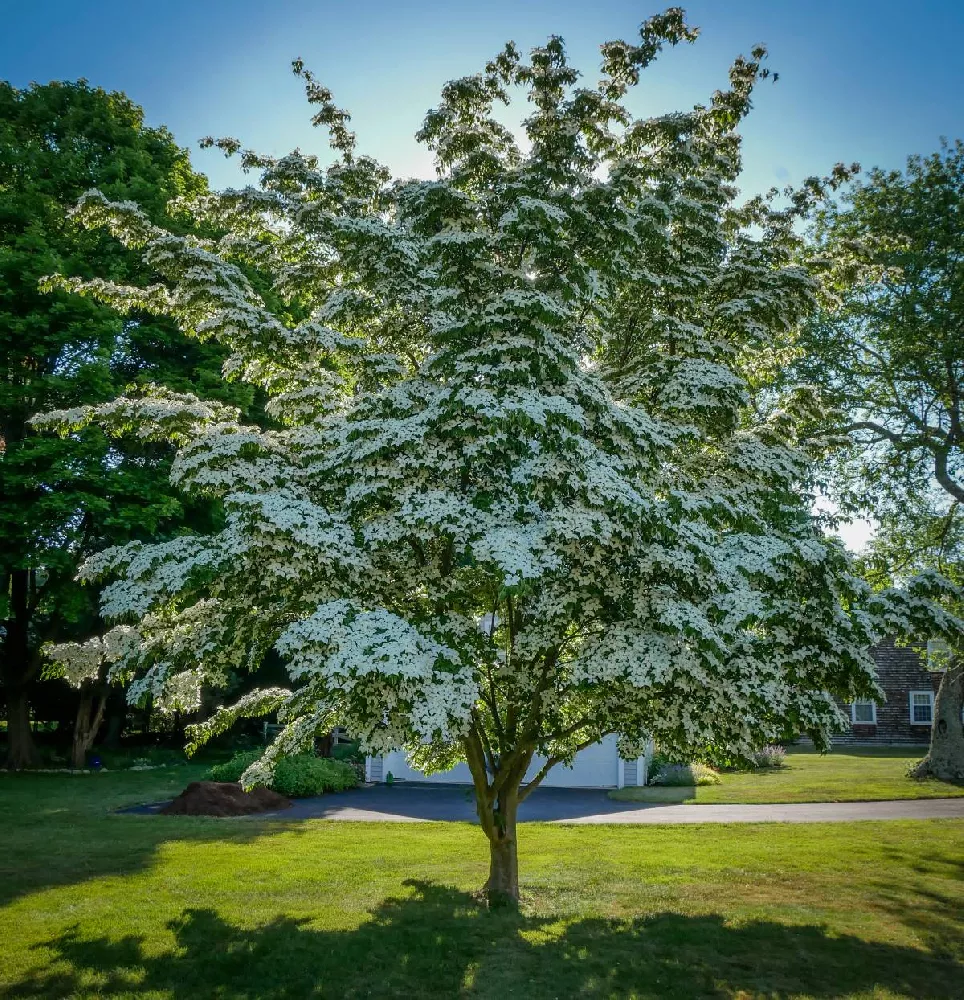- Home >
- Flowers >
- Trees and Plants with White Flowers >
- Starlight Flowering Dogwood Tree
Starlight Flowering Dogwood Tree for Sale - Buying & Growing Guide
The Starlight Flowering Dogwood Tree is one of the few ornamental plants that can truly add visual appeal to your garden at nearly all times of the year. This cultivar, known botanically as Cornus 'KN4-43,' becomes the ideal garden focal point when it blooms in spring with copious amounts of white flowers. The Starlight Flowering Dogwood also boasts some striking red fall foliage, beautiful exfoliating bark, and a growth habit that remains graceful all year long.
- The Starlight Flowering Dogwood Tree blooms with many brilliant white flowers.
- In fall, this tree's leaves turn an impressive red color.
- The Starlight Flowering Dogwood Tree can be an impressive focal point in any garden.
Enter your zip code to find nearby stores that may carry this plant.
Plant Care
Sunlight

The Starlight Flowering Dogwood Tree can survive in partial shade and full sun settings.
Watering
Water this plant whenever you notice that the first two to three inches of soil have dried out.
Fertilizing

Use a balanced all-purpose fertilizer once per year during mid-spring.
Planting and Care
Planting instructions
In the warmer parts of the Starlight Flowering Dogwood Tree’s range, it can grow well in full sunlight. However, in the warmer parts of that range, it is typically best to use a partial shade growing location. This plant can also adapt to many soil types but does best in soils that are moist but well-draining with plenty of organic nutrients. Once you find a suitable area, plant your Starlight Flowering Dogwood Tree in a hole that is as deep as the root ball is tall and about twice as wide.
Watering and nutrients
After planting your Starlight Flowering Dogwood Tree, you should plan to water it often enough to maintain consistent soil moisture throughout the first growing season. Following the first growing season, you should water this plant based on soil moisture. Add water whenever you notice that the first two to three inches of soil have dried out. Fertilizer is not always necessary for the Starlight Flowering Dogwood Tree, but if you want to feed this plant, you can apply a balanced fertilizer once per year in the spring.
Pollination
As is true of many flowering dogwood varieties, the Starlight Flowering Dogwood Tree has flowers that contain both male and female structures. In most instances, the presence of male and female structures on the same plant ensures that the plant can reproduce on its own. However, many dogwoods can be self-incompatible, meaning that they need a companion plant to conduct pollination. Typically, the Starlight Flowering Dogwood Tree relies on flying insects to carry its pollen from one flower to another.
Pruning
You should be careful when choosing a time to prune your Starlight Flowering Dogwood Tree. While many trees respond well to pruning in spring, this tree will often bleed a lot of sap if you prune it at that time. As such, it is typically better to perform light pruning during the late spring or summer months. Additionally, you can make larger pruning cuts during the dormant winter season, but this comes with the risk of removing the next season’s blooms.
Pests, diseases and animals
Sadly, dogwood trees, including the Starlight Flowering Dogwood Tree, are known to experience many pest and disease issues throughout their lives. Some of the most noticeable disease complications that this tree experiences will result in spots of discoloration on the leaves and petals. Anthracnose can also be a common problem for this species, but the Starlight Flowering Dogwood Tree has better resistance to that affliction than other dogwoods. Along with those diseases, this plant can also experience infestations of insects, with borers and midges being the most common.
Achieving maximum results
Although the Starlight Flowering Dogwood Tree is a lovely specimen that grows well in many locations, you should consider its mature size before planting it. While this plant will fit well in a small planting location during its youth, it will eventually reach a size that could amount to 30 feet tall and 30 feet wide at most. You should account for this significant spread when planting your Starlight Flowering Dogwood. However, if you find that you need to change this plant’s growing location, you shouldn’t have much trouble transplanting it since it has a shallow root system.
FAQs
What do the fruits of a Starlight Flowering Dogwood look like?
Although gardeners do not typically grow the Starlight Flowering Dogwood Tree for its fruits, those fruits can add a surprising amount of ornamental appeal. These fruits are small, round and berry-like with a vibrant red color. That bright color provides a lovely contrast during the later stages of the growing season and adds to the overall attractiveness of this impressive tree.
Can you grow the Starlight Flowering Dogwood Tree in a container?
It is possible to grow a Starlight Flowering Dogwood Tree in a container. However, this is only possible while it is young. This plant can eventually reach a considerable mature size of 30 feet or more, which means that it will outgrow a container setting during its development. Since this plant will eventually outgrow even the largest garden containers, it is best to plant it in the ground from the onset.
Is the Starlight Flowering Dogwood Tree a native species?
The Starlight Flowering Dogwood Tree is not a native species. In fact, it is not a naturally-occurring plant at all. Instead, it came into being via a cross between two existing species—the Cornus kousa and Cornus nuttallii. That cross resulted in a beautiful dogwood tree that has slightly better disease resistance than most. However, while this plant is a cultivated variety, it has started to naturalize in many parts of the United States.
Compare Similar Products
You can't add more Product Name - Product size to the cart.
OK








